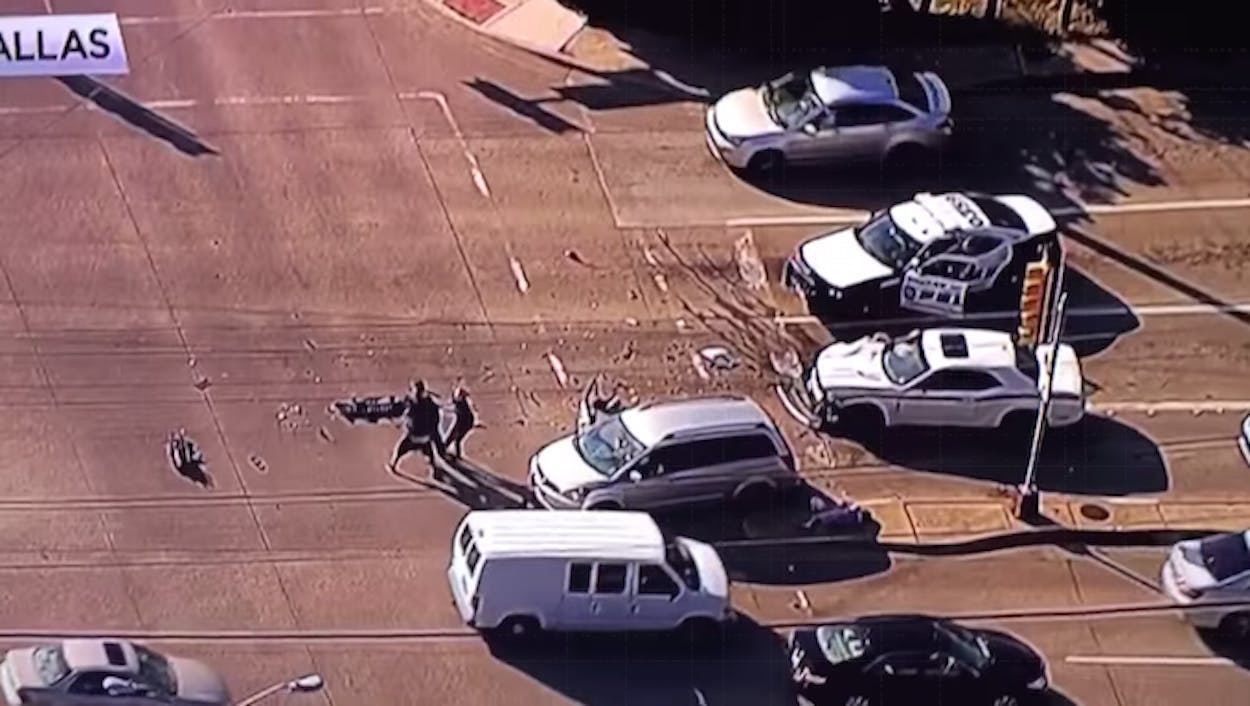Hey Texas, here’s a thing that happened last week in Dallas: a high-speed police chase! Those are always exciting, dangerous, and very stupid, which is why police departments around the country tend to restrict their officers from participating in them. The risk of a bystander being hurt in order to catch someone whose crime is usually not a felony offense is hard to justify. (An average of 360 deaths occurred as a result of chases each year between the 1980’s and 2010, and a third of them were bystanders.)
Still, when an armed suspect is believed to have committed a violent crime, a high-speed police chase is condoned. Such was the case in Dallas last week, after a man allegedly stole a car at gunpoint and then charged through North Dallas:
Police said Alexander stole the Dodge Challenger from a convenience store in the 3000 block of Grand Avenue, near Fair Park. According to police, the owner of the car had left the vehicle running while he went into the convenience store.
Police said the man tried to approach the vehicle when Alexander pointed a gun at him and fled.
The chase ended at Walnut Hill Lane and Abrams Road, where Alexander crashed into a gray minivan and black SUV. The 13-year-old boy in the minivan was transported to Children’s Medical Center Dallas for evaluation. He was released shortly after.
This chase isn’t particularly notable, except for how it ends. After the suspect plows into the minivan, the woman driving the car gets out of her vehicle, rushes over to his SUV, and proceeds to, er, beat the hell out of the guy. All of this was magically caught on video:
The video is remarkable. The woman responds in the way we’d all like to imagine we might, if our lives and the lives of our families were jeopardized by some asshole who decided to put them at risk for no reason, and the fact that she helps the police make the arrest of a guy whom, it’s pretty clear, the streets are safer without, doesn’t hurt any.
Indeed, the “Mama Bear” in the video, Jessica Liesman, has been celebrated for her courage and gumption—a Kia dealership in Mesquite gave her the minivan of her choice to replace the one that was damaged in the wreck, and a GoFundMe campaign to raise money for her launched shortly after the video went viral. (Liesman, furthering her “hero” cred, popped into the comments to refuse the money, insisting that any funds raised go toward someone else whose car was damaged in the crash.) There’s another video of her, from the Dallas Morning News, as she receives the new car, tearful and humble. We should all aspire to be as gracious as Liesman in the event that we end up briefly Internet-famous. (“What do we do now?” Liesman asks through tears. “You drive away in your brand-new car,” the dealer responds.)
In short, Liesman is great—but it’s unfortunate that she should have ever been in that position in the first place. Dallas Police Department policy in high-speed chases is fairly restrictive:
The Dallas Police Department restricts pursuits to the following circumstances: probable cause to believe a felony was committed that involved the use or threat of force; the officer reasonably believes the suspect poses a danger to the public that outweighs the risks posed by the pursuit; and to assist another law enforcement agency that has initiated a pursuit under the aforementioned circumstances.
In this instance, the policy appears to have been well-observed—the car was stolen at gunpoint, and the suspicion that other gun crimes might have been committed by the driver is not unfounded. But the culture of high-speed chases—in Dallas and elsewhere—is changing, and for good reason. A 2009 incident in Dallas led to demotions and suspensions, after a chase with multiple cars involved serious safety violations including “barreling through school zones and residential areas at high speeds, running up on sidewalks, failing to obey traffic control devices and going the wrong way on one-way streets,” according to the Dallas Morning News.
An attorney for the officers in that case declared that the decision to discipline the officers “sends a ‘message that they want officers to let felons go.’” But a Popular Mechanics article about high-speed chases from 2013 found that that’s frequently not the way these incidents actually play out:
“Chasing was far more prominent back in the day when there was not as much training and officers had more leeway,” [South Carolina Criminal Justice Academy Driver Instructor course, chief instructor James] Vaughan says. “There’s been evolution of the profession through better training and better policies. Also, departments that have experienced litigation are encouraged to change their policies by insurance-fund administrators.”
Will limited-pursuit polices cause more drivers to flee, knowing police regulations restrict high-speed pursuits? An IACP study found no evidence to support that. Also, interviews with people who have fled from the police, conducted by the National Institute of Justice, revealed that the offenders returned to normal driving within about 90 seconds of the chase’s being abandoned.
In other words, the DPD policy seemed to have been followed in this case, and it doesn’t appear that anyone was seriously injured in the collision that destroyed Liesman’s car and brought out the “Mama Bear” instinct that made the video go viral. But it’s worth asking a question: If there are already technologies like police drones and license plate readers in place to control traffic, are high-speed chases ever really necessary?








